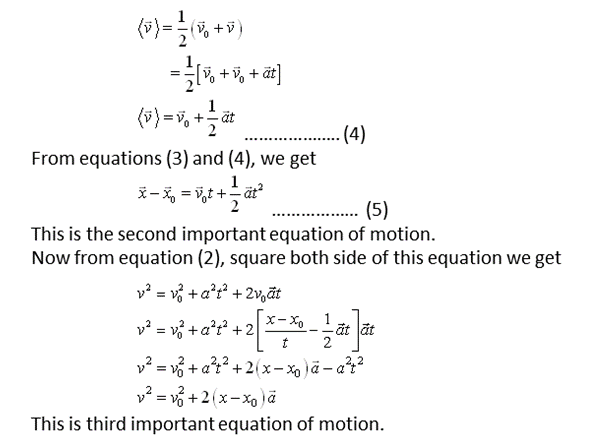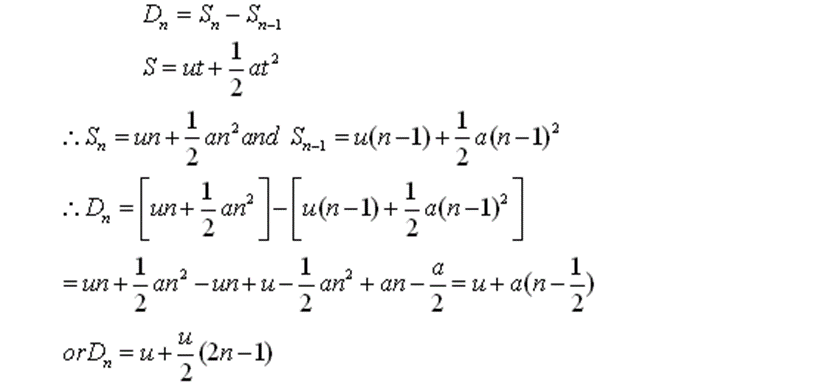Equations of motion
The relationship among different parameter like displacement, velocity, acceleration can be derived using the concept of average acceleration and instantaneous acceleration.
There are three formulae or equations of motion for uniformly accelerated motion: velocity time relation, position time relation and position velocity relation.
When acceleration is constant, a distinction between average acceleration and instantaneous acceleration loses its meaning, so we can write
![]() ……………..(1)
……………..(1)
where v0is the velocity at t = 0 and v is the velocity at some time t
Now
![]()
Hence,![]() .................. (2)
.................. (2)
This is the first useful equation of motion.
Similarly for displacement
![]() .................. (3)
.................. (3)
in which x0is the position of the particle at t0and is the average velocity between t0and later time t. If at t0and t the velocity of particle is

Note:The equations of motion derived above are possible only in uniformly accelerated motion i.e. the motion in which the acceleration is constant.
Distance travelled in nth second
Let,
u = initial velocity
a = uniform acceleration
Sn, Sn-1= distance travelled in n and (n-1) seconds respectively.
Dn= distance travelled in nth second, then

Example: The displacement x of a particle moving in one dimension, under the action of a constant force is related to the time t by the equation t = √x + 3 where x is in meter and t is in seconds. Find the displacement of the particle when its velocity is zero.
Solution: Here t = √x + 3 => √x = t - 3
Squaring both sides, we get x = t2- 6t + 9,
As we know velocity, v = dx/dt
Hence we get v = dx/dt = 2t - 6
Put v = 0, we get, 2t - 6 = 0 .•. t = 3s
When t = 3s, x = t2- 6t + 9 = 9 - 6(3) + 9 = 0
Hence the displacement of the particle is zero when its velocity is zero.
Example:A body moving with a constant retardation in straight line travels 5.7 m and 3.9 m in the 6thand 9thsecond, respectively. When will the body come momentarily to rest?
Solution: A body moving with initial velocity u and acceleration a, traverses distance Snin nthsecond of its motion.
Sn= u + (1/2)(2n - 1)a
=> 5.7 = u + (1/2)(2 x 6 - 1) a
or 5.7 = u + (11/2) a ………………………..(1)
and 3.9 = u + (1/2)(2 x 9 - 1)a
or, 3.9 = u + (17/2) a ………………………….(2)
Solving eqns. (1) and (2) we get, u = 9 m/s and a = -0.6 m/s2.
If the body stops moving after t seconds, then from the relation v=u+at
0 = 9 + (-0.6)t or, t = (9/0.6)s = 15s
Example:A bullet fired into a fixed target loses half of its velocity after penetrating 3 cm. How much further it will penetrate before coming to rest assuming that it faces constant resistance to motion.
Solution:Let initial velocity of the bullet = u
After penetrating 3 cm its velocity becomes = u/2
From v2= u2- 2as
(u/2)2= u2- 2as
.•. a= u2/8
Let further it will penetrate through distance x and stops at some point
0 = (u/2)2- 2 (u2/8)x
.•. x = 1 cm
Motion under Gravity
When a body is dropped from some height (earth's radius = 6400 km), it falls freely under gravity with constant acceleration g (= 9.8 m/s2) provided the air resistance is negligible small.
The same set of three equations of kinematics (where the acceleration remains constant) are used in solving such motion. Here, we replace$\overrightarrow{a}$a by$\overrightarrow{g}$g and choose the direction of y-axis conveniently. When the y-axis is chosen positive along vertically downward direction, we take
as positive and use the equation as
v = u + gt,
v2= u2+ 2gh,
and h = ut + 1/2gt2
where h is the displacement of the body and u is initial velocity of projection in the vertically downward direction. However, if an object is projected vertically upward with initial velocity u, we can take y-axis positive in the vertically upward direction and the set of equations reduces to
v = u - gt,
v2= u2- 2gh,
and h = ut - 1/2gt2
In order to avoid confusion in selecting$\overrightarrow{g}$g as positive or negative, it is advisable to take the y-axis as positive along vertically upward direction and point of projection as the origin. We can now write the set of three equations in the vector form:
![]()
Where h is the displacement of the body.
Example: An anti-aircraft shell is fired vertically upwards with a muzzle velocity of 294 m/s. Calculate
(a) the maximum height reached by it;
(b) time taken to reach this height;
(c) the velocities at the ends of 20thand 40thsecond.
(d) When will its height be 2450 m? Given g = 9.8 m/s2.
Solution:(a)Here, the initial velocity u = 294 m/s and g = 9.8 m/s2
.•. The maximum height reached by the shell is,
H = u2/2g = 2942/(2 x 9.8) = 4410 m = 4.41 km
(b)The time taken to reach the height is, T = u/g = 294/9.8 = 30 s
(c)The velocity at the end of 20thsecond is given by
v = u - gt = 294 - 9.8 x 20 = 98 m/s upward,
and the velocity at the end of 40thsecond is given by,
v = 294 - 9.8 x 40 = -98 m/s
The negative sign implies that the shell is falling downward.
(d)From the equation
H = ut + (1/2)gt2or2450 = 2941 t - 1/2 x 9.8 t2
or t2- 60 t + 500 = 0
.•. t = 10 s and 50 s.
At t = 10 s, the shell is at a height of 2450 m and is ascending, and at the end of 50 s it is at the same height, but is falling.